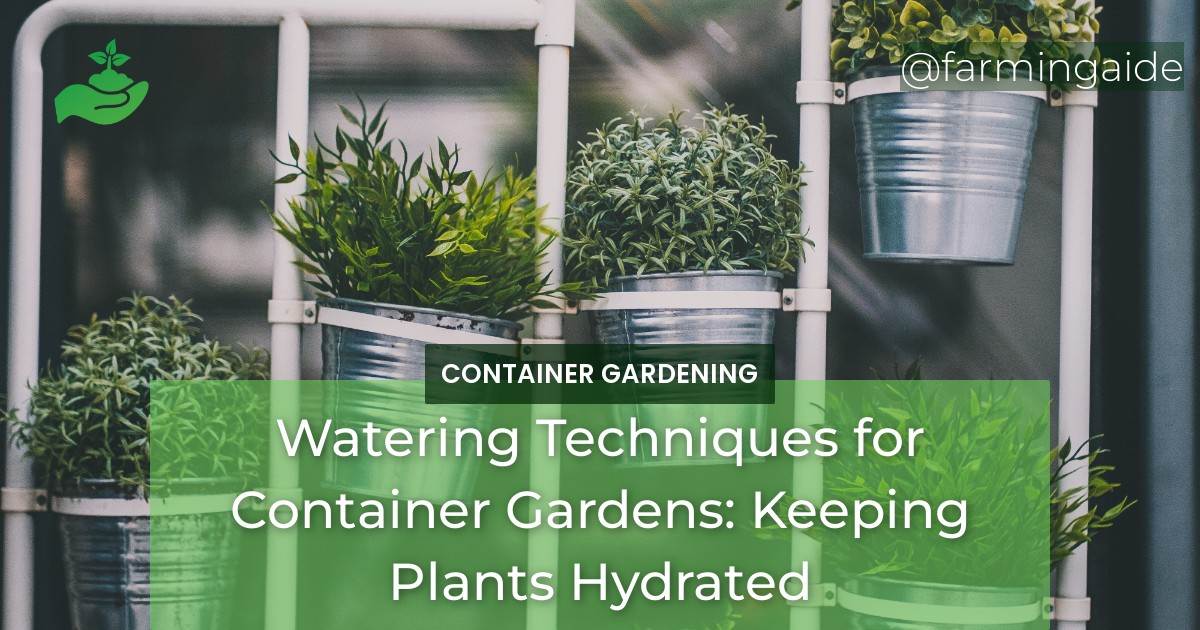Container gardening is a popular and efficient way to grow plants in urban areas or smaller spaces. However, maintaining the proper hydration level of plants in container gardens can be a challenge.
In this article, we will discuss the importance of proper watering techniques for container gardens and provide tips and techniques to keep your plants hydrated.
Table of Contents
Importance of Proper Watering Techniques for Container Gardens:
Preventing Overwatering:
Overwatering is a common mistake made by novice gardeners. It can lead to root rot and other plant diseases. To prevent overwatering, it is important to understand the moisture level of the soil and how much water the plants need.
Avoiding Underwatering:
Underwatering can also have adverse effects on plants. It can cause plants to wilt and become more susceptible to pests and diseases. Additionally, a lack of water can reduce the yield of fruits and vegetables. Therefore, it is important to provide adequate hydration to plants in container gardens.
Effective Watering Methods for Container Gardens:
Understanding Soil Moisture Levels:
Knowing the moisture level of the soil is crucial in determining watering frequency. To check soil moisture, insert your finger about two inches below the soil surface. If the soil feels dry, it is time to water.
Determining Watering Frequency:
The watering frequency depends on various factors, including the type of plant, climate, and container size. In general, plants in smaller containers require more frequent watering than those in larger containers. On average, most container plants need to be watered once a day, but it may vary depending on the weather conditions.
ALSO READ
Techniques for Watering Container Gardens:
Drip Irrigation:
Drip irrigation is an efficient way to water container gardens. It involves using a hose with tiny holes that drip water directly onto the soil. This method reduces water waste and ensures that the plants receive the required amount of water.
Watering from Above:
This is the most common watering method. It involves using a watering can or hose to water plants from above. However, it can lead to soil erosion and water wastage if not done correctly.
Bottom Watering:
Bottom watering involves filling a tray or saucer with water and placing the container on it. As plants absorb the water from the bottom, the soil remains moist, and there is less evaporation.
Additional Tips for Maintaining Proper Hydration in Container Gardens:
Mulching:
Mulching involves covering the soil surface with a layer of organic material like leaves or straw. It helps to retain moisture in the soil, prevent soil erosion, and reduce weed growth.
Providing Adequate Drainage:
Containers with proper drainage holes allow excess water to drain out and prevent waterlogging. It is essential to choose containers with adequate drainage holes and ensure that the holes do not get clogged.
Common Mistakes to Avoid When Watering Container Gardens:
Watering at the Wrong Time:
It is best to water plants early in the morning or late in the evening to avoid water wastage and evaporation.
Overcrowding Containers:
Overcrowding containers can lead to competition for resources like water and nutrients. It is important to provide adequate space for each plant to grow and thrive.
Neglecting to Monitor Watering Needs:
It is important to monitor the moisture level of the soil and adjust the watering frequency accordingly. Neglecting to monitor watering needs can lead to over or under-watering of plants.
Conclusion:
Proper watering techniques are essential for maintaining the health and productivity of plants in container gardens. Understanding soil moisture levels, determining watering frequency, and using effective watering techniques like drip irrigation and bottom watering can ensure that your plants receive adequate hydration. Additional tips like mulching and providing adequate drainage can also help maintain proper hydration levels. By avoiding common mistakes like watering at the wrong time, overcrowding containers, and neglecting to monitor watering needs, you can keep your container garden healthy and thriving.
RELATED ARTICLES:


